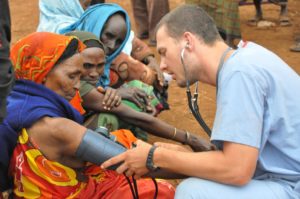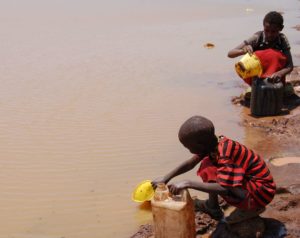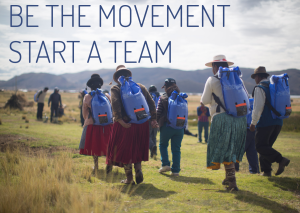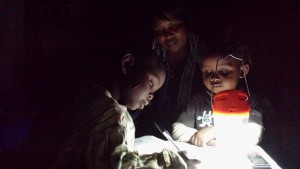 Some people assume that enormous problems are for somebody else to solve. Others are undaunted and confront the challenge. Meet two women in the latter category, each of whom is an army of one.
Some people assume that enormous problems are for somebody else to solve. Others are undaunted and confront the challenge. Meet two women in the latter category, each of whom is an army of one.
The first is Connie Cheren of Alpharetta, Ga. When the last of her five children graduated from college, Connie found herself in the enviable position of suddenly having extra time and money on hand. What to do? She chose to focus on improving the lives of people in Kenya
In 2007, Connie created Partners for Care, a non-profit whose mission “is to decrease the number of children dying from preventable diseases—malaria, HIV/AIDS, waterborne illnesses, and malnutrition—by supporting Kenyan nationals who do the work.”
It took three trips to Africa for Connie to see her role. The first was nine years ago. Connie took part in an AIDS mission trip to South Africa where her youngest daughter, Mindy, was studying. The second was a mission trip to Kenya sponsored by her church. Connie found the experience of the slums—the smells, the dirt—to be overwhelming, even oppressive. “No, thanks,” she thought to herself.
It was the third trip, a medical mission, again sponsored by her church, when the revelation hit her. “Maybe I can do something.” She realized she didn’t have to fix the slums. Her job would be to identify local leaders, mentor and provide them with the resources they needed to bring improvement to their own communities.
Connie headed to Nairobi, Kenya, and rented an apartment. With no resources in hand—outside of the smarts and skills that come with being a nurse with a master’s in social work, and the experience that comes from raising five children—she set out to learn what basic needs were not being met. She visited the camps that had been set up for the thousands of people who had been displaced by the violence that followed a contested election in 2007.
Connie remembers, “The nation was burning.” She talked to the people in the camps and local government officials, and slowly the pieces fell into place.
The result? Partners for Care now has a staff of 40 in Kenya and works in the Nairobi slums, as well as those places where many don’t go—villages in the deep interior of Kenya where people live in mud huts.
Connie’s work has three components. The first is the simple process of assessing the situation, developing a plan, implementing and then evaluating it. Second, she sees to it that the people who provide services have the basic tools necessary to deliver those services, and, third, those who receive services either pay a small amount or perform work in the community.
With her staff in Kenya, Connie has created a literacy program and an IT school, created medical clinics, and has distributed over 5,000 water backpacks that help people transport safe water. To support her staff, Connie travels to Kenya five to six times a year for two to three weeks at a time.
The second army of one is Kelsey Langdale of Columbus, Ohio, who heads PackH2O, a non-profit that raises funds for the distribution of water backpacks in the developing world. It’s through these backpacks that Kelsey and Connie met.
 The next time you pour a glass of water, think about this: a billion people don’t have access to safe water. Women and children in the developing world spend hours each day getting water. Often, they carry water in “jerrycans,” rectangular five gallon cans that previously held gasoline or pesticides. Because the cans are contaminated, they can turn safe water into water that causes illness.
The next time you pour a glass of water, think about this: a billion people don’t have access to safe water. Women and children in the developing world spend hours each day getting water. Often, they carry water in “jerrycans,” rectangular five gallon cans that previously held gasoline or pesticides. Because the cans are contaminated, they can turn safe water into water that causes illness.
Carrying the jerrycans—strapped to the back, balanced on the head—is hard, painful work and debilitating to the shoulders, neck and spine. Remember, five gallons of water weighs about 45 pounds.
Kelsey saw the problem during a relief trip to Haiti after it was leveled by an earthquake in 2010. “When you’re in a community that’s just been hit with disaster, you think about the true necessities,” she says. “It starts with water.”
Two of the men on the relief trip were executives with Greif, a world leader in industrial packaging. They recognized that some of jerrycans being used to carry water had been produced by Greif and could tell they once carried toxic chemicals.
 The execs figured they could create a safe, comfortable way to carry water, and so they developed the PackH2O backpack. The non-profit by the same name was launched on World Water Day, March 22, in 2012. Since then, more than 200,000 packs have been distributed in over 35 countries worldwide, from Peru to Kenya to Nepal, as well as in southern California in response to natural disasters
The execs figured they could create a safe, comfortable way to carry water, and so they developed the PackH2O backpack. The non-profit by the same name was launched on World Water Day, March 22, in 2012. Since then, more than 200,000 packs have been distributed in over 35 countries worldwide, from Peru to Kenya to Nepal, as well as in southern California in response to natural disasters
The model for PackH2O is simple. Kelsey raises funds that are donated to a relief agency such as Partners for Care, which then purchases the packs for $10 each from a for-profit company associated with PackH2O and Greif. The agency either sells the packs for whatever the local market will bear (about $2 in Kenya) or provides the packs in exchange for work within the community. Because Kelsey’s salary is covered by Greif, all money she raises is donated to relief agencies.
Connie and Kelsey employ a simple paradigm: identify a problem that afflicts those who have less and then commit to fixing it. When you’re an army of one, you persevere.
_____________________________________
Jack D’Aurora writes for considerthisbyjd.com
___________________________________________________
ShareMAY


About the Author: